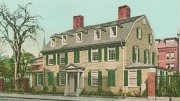A music stand of East Indian rosewood, with maple laminated veneers curved as delicately as a clef, stands rooted in a solid base so that it leans toward the musician with assurance. It expresses the remarkable integration of art and utility in the one-of-a-kind pieces by furniture designer/maker Anthony Giachetti, A.M. ’69. Each work has a distinct function—but their enduring aesthetic appeal is even more prominent. “Timelessness is something that I think about constantly in the design process,” he says.
Attorney Charles Edson ’56, J.D. ’59, and his wife can attest to this, having purchased a fluted sideboard Giachetti made for a show in 1982—one of three of his pieces that they own. “I thought it was smashing looking, and asked him if he could expand on the idea,” Sue Edson recalls. They commissioned a seven-foot-long French walnut desk with fluted, curved verticals. “I like Tony’s work just as much today as when we purchased it,” she says, “and I can’t say that about the work of many artists that we have around the house.”
All of Giachetti’s pieces are privately held, save a tiger maple bench with ebony inlay whose “concave sides and central arch testify to Giachetti’s mastery of lamination,” according to literature from the Yale University Art Gallery, where it remains on display 25 years after its acquisition. To achieve its type of dramatic curve, he slices wood to a one-eighth-inch thickness with a band saw, then sands, bends, and glues at least seven plies—one at a time, in order, to match the grain—to a carefully formed particleboard. Calculating different concentric lines requires the creator “to put on that engineering hat,” he says. Yet even the meticulous placement of materials remains an organic art. “Never is a match perfect, because the wood changes in grain and color as you cut sequentially from sap to heartwood,” he explains. This allows the furniture to “tell the tale of the tree.”
Giachetti, who divides his time between East Boothbay, Maine, and Chapel Hill, North Carolina, hand-selects wood from importers in New York City; favorites include curly maple, Swiss pearwood, curly mahogany, rosewood, walnut, cherry, quartered oak, French walnut, and English brown oak. Beauty attracts him first. The wood, when finished with oil, must “have a look and feel that enhances the grain pattern and is as smooth as silk,” he says. But he also chooses materials that have “the strength necessary for quality-built furniture to last many lifetimes.” The decision to use a particular variety depends on the purpose of a piece or a client’s preferences.
The Shaker tradition, featuring exposed joinery and elegant lines, informed Giachetti’s early work. Over time the more complex English Arts and Crafts style sparked his imagination, forcing his skills to follow suit. “If you are doing one-of-a-kind work,” he says, “it’s important to strike a balance between developing and refining a design over a number of pieces, and then knowing when you should move on.”
Details indicative of Giachetti’s style include 16 fluted and inlaid curly mahogany door verticals in barrel-stave construction on a cabinet inspired by the designs of twentieth-century Italian architect Paolo Portoghesi. Occasionally, whimsical touches grace the refinement, as with doors on a French- and black-walnut butterfly cabinet that open toward the center, like wings. A jewelry chest, raised on slender legs, contains 29 miniature drawers of different sizes, evoking a sophisticated puzzle. Each intricate piece may take eight or nine weeks of intense work to complete.
When Giachetti started, he sold a walnut table for less than $500. By the early 1990s, when he was working exclusively through private commissions and juried shows, one of his desks sold through the American Crafts Council for $10,000, and another was appraised at $30,000.
Yet his first clients paid nothing at all: Giachetti began by building furniture for his own home in the late 1960s and early 1970. He was pursuing a Harvard Ph.D. in economics and met his future wife, Nikki Schumann ’70, an artist who sharpened her silk-screening prowess on the iconic “red fist” posters for the student strikes of 1969. Though he’d never picked up a tool, Giachetti decided—for reasons he still can’t quite explain—to furnish their apartment with his own handiwork. So he purchased textbooks, set up shop in a friend’s basement, and started teaching himself the art of furniture making “instead of writing my dissertation.”
Six months later, the completion of a cherry-wood dining table cued the shift from hobby to lifelong vocation. “I was making something tangible,” he recalls. “It just seemed much more immediate and gratifying.”













